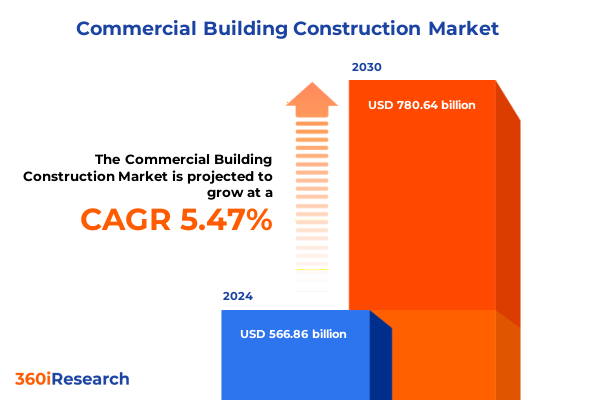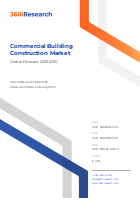The Commercial Building Construction Market size was estimated at USD 566.86 billion in 2024 and expected to reach USD 596.39 billion in 2025, at a CAGR 5.47% to reach USD 780.64 billion by 2030.

Introduction and Strategic Context for Commercial Construction
Commercial building construction stands at a pivotal crossroads where strategic foresight and adaptive execution define long-term success. As urbanization accelerates and economic cycles fluctuate, developers and contractors must navigate increasing complexity in project planning, financing, and regulatory compliance. Emerging priorities, from net-zero targets to digital integration, reshape traditional workflows and demand a proactive stance on innovation. In this environment, understanding the broader market context becomes essential: decision-makers require timely intelligence on shifting demand drivers, evolving risk factors, and the competitive landscape. By situating commercial construction within a dynamic global framework, stakeholders can identify opportunities to optimize resource allocation, mitigate supply-chain disruptions, and capitalize on sustainable design mandates. This introduction outlines the fundamental forces shaping the industry, setting the stage for a detailed exploration of transformative trends, tariff impacts, segmentation clarity, regional dynamics, and competitive intelligence. It underscores the need for a cohesive strategy that aligns operational excellence with strategic agility across every phase of the construction lifecycle.
Transformative Shifts Redefining Commercial Construction
Several concurrent shifts are redefining the commercial construction landscape and setting new benchmarks for performance. First, the integration of digital tools - from BIM platforms to IoT-enabled sensors - accelerates project delivery and enhances real-time decision-making. These technologies streamline collaboration among architects, engineers, and contractors, reducing rework and minimizing on-site safety incidents. Second, sustainability imperatives have evolved from niche considerations to core criteria: developers increasingly pursue low-carbon materials, energy-efficient building envelopes, and renewable energy systems. As ESG reporting becomes standard practice, projects that meet or exceed sustainability metrics are attracting premium financing and accelerated permitting. Third, modular and off-site construction methodologies are gaining traction, driven by labor shortages and the need for predictable timelines. Prefabrication of structural elements and bathroom pods in controlled environments reduces on-site labor intensity while improving quality control. Finally, resilience planning - encompassing climate-related risk assessments and adaptive design - is becoming integral. Cities prone to extreme weather are mandating flood-resistant and seismic-resilient structures, creating demand for advanced materials and engineering services. These transformative forces collectively set a new bar for cost efficiency, quality, and environmental performance.
Assessing the 2025 Tariff Impact on U.S. Construction Costs
In 2025, the cumulative impact of United States tariffs on imported steel, aluminum, and specialty materials continues to reverberate across project budgets and timelines. Increased duties on structural steel and cold-formed steel have raised input costs by an estimated double-digit percentage, compelling contractors to seek alternative suppliers or redesign load-bearing elements using higher-grade domestic steel. Tariffs on precast and reinforced concrete additives, including polymer admixtures, have also driven material substitutions, occasionally resulting in delays as qualification tests and code approvals are completed. Moreover, import duties on engineered and laminated wood components have prompted developers to explore local mill partnerships while investing in cross-laminated timber technology to maintain design integrity and sustainability commitments. These trade policies have compounded existing supply-chain pressures, leading to extended lead times and higher freight costs. Many firms are responding by diversifying supplier portfolios, negotiating long-term off-take agreements, and localizing manufacturing footprint to hedge against future tariff volatility. Overall, the tariff regime has underscored the critical importance of strategic procurement planning and collaborative risk sharing among project stakeholders.
In-Depth Segmentation Insights Across Materials, Types, and Buildings
A nuanced understanding of market segmentation reveals where investment and innovation priorities converge. Based on building materials, the market divides into concrete, steel, and wood categories. Within concrete, both precast concrete panels and reinforced concrete foundations serve as the backbone of high-rise and heavy-load structures. Structural steel and cold-formed steel support a range of applications from warehouse frames to sophisticated architectural facades, while engineered wood and laminated wood solutions are gaining favor in mid-rise and low-rise commercial facilities for their sustainability and speed of assembly. Turning to construction type, new construction projects drive major capital-intensive ventures, while renovation efforts-from facade renovation refurbishments to comprehensive interior remodeling-address urban renewal and tenant-fit-out demands. Historical restoration and modern adaptation initiatives further extend asset lifecycles, blending heritage preservation with contemporary functionality. Finally, by building type, data centers and industrial warehouses emphasize high-density infrastructure and specialized mechanical systems, whereas educational campuses and healthcare facilities-comprising schools, universities, hospitals, and laboratories-prioritize occupant safety, accessibility, and energy performance. Retail buildings round out the landscape, requiring flexible floorplates and experiential design to meet evolving consumer expectations.
This comprehensive research report categorizes the Commercial Building Construction market into clearly defined segments, providing a detailed analysis of emerging trends and precise revenue forecasts to support strategic decision-making.
- Building Materials
- Construction Type
- Building Type
Regional Dynamics Shaping Market Opportunities and Challenges
Regional dynamics exert a profound influence on commercial construction strategies as economic growth, regulatory frameworks, and infrastructure priorities diverge across geographies. In the Americas, recovery in office occupancy and logistics expansion fuel demand for urban infill projects, while sustainable bond issuances pour capital into energy-efficient retrofits. Supply-chain resilience remains a top concern, with nearshoring initiatives reshaping procurement for key materials. In Europe, the Middle East & Africa, stringent energy performance regulations in the EU and ambitious megaprojects in Gulf states drive both innovation and competitive pressure; African markets‚ in turn‚ exhibit robust demand for educational and healthcare facilities as populations and urban centers expand. The Asia-Pacific region is characterized by rapid urbanization, with smart city initiatives and data-center growth underpinning significant commercial construction pipelines; regional variations in regulatory stringency and labor availability encourage a mix of traditional in-situ construction and off-site prefabrication methodologies. Across all territories, cross-border collaborations and public-private partnerships are becoming indispensable for navigating financing complexities and local compliance requirements.
This comprehensive research report examines key regions that drive the evolution of the Commercial Building Construction market, offering deep insights into regional trends, growth factors, and industry developments that are influencing market performance.
- Americas
- Asia-Pacific
- Europe, Middle East & Africa
Leading Players Steering Commercial Construction Trends
Leading growth and innovation in the commercial construction sector are a diverse group of global and regional firms, each bringing specialized expertise and strategic focus. Organizations such as AECOM and Jacobs Engineering Group Incorporation excel at large-scale infrastructure integration, while Turner Construction Company and Clark Construction Group, LLC, demonstrate prowess in complex urban high-rise developments. Balfour Beatty Infrastructure, Inc and Bouygues Construction leverage modular construction capabilities to reduce project timelines, just as DPR Construction, Inc. and McCarthy Building Companies, Inc. drive lean construction practices and digital adoption. Fluor Corporation and Fluor’s peers-Gilbane Inc. and Hensel Phelps Construction Co.-have built reputations on mega-project management and turnkey delivery. Regional specialists like Grupo ACS and Hochtief Group focus on transcontinental partnerships, whereas Suffolk Construction Company, Inc. and Manhattan Construction Group excel in client-centric, design-build models. Companies such as Laing O’Rourke and Lendlease Group invest heavily in research and development of sustainable materials, paralleled by The Walsh Group and Tutor Perini Corporation’s significant footprints in healthcare and education facilities. Meanwhile, niche innovators like PCL Construction Enterprises, Inc. and Whiting-Turner Contracting Company are pioneering advancements in prefabrication and digital project controls. This ecosystem of players fosters competitive differentiation and accelerates adoption of next-generation construction technologies.
This comprehensive research report delivers an in-depth overview of the principal market players in the Commercial Building Construction market, evaluating their market share, strategic initiatives, and competitive positioning to illuminate the factors shaping the competitive landscape.
- AECOM
- Balfour Beatty Infrastructure, Inc
- Bouygues Construction
- Caddell Construction Co. (DE), LLC
- Clark Construction Group, LLC
- DPR Construction, Inc.
- Fluor Corporation
- Gilbane Inc.
- Grupo ACS
- Hensel Phelps Construction Co.
- Hochtief Group
- Jacobs Engineering Group Incorporation
- JE Dunn Construction Group, Inc.
- Laing O’Rourke
- Lendlease Group
- MA Mortenson Company
- Manhattan Construction Group
- McCarthy Building Companies, Inc.
- Nippon Concrete Industries Co., Ltd
- PCL Construction Enterprises, Inc.
- Royal BAM Group
- Suffolk Construction Company, Inc.
- Sundt Construction, Inc.
- Takada Corporation
- The Walsh Group
- Turner Construction Company
- Tutor Perini Corporation
- Whiting-Turner Contracting Company
- Zachry Construction Corporation
Actionable Recommendations for Industry Leaders
Industry leaders should adopt a proactive, multifaceted strategy to capitalize on emerging opportunities. Begin by institutionalizing digital twins and integrated project delivery protocols to improve cost predictability and accelerate decision cycles. Next, prioritize sustainability roadmaps that encompass low-carbon materials sourcing-such as cross-laminated timber-and net-zero building design, while leveraging green financing instruments to lower capital costs. Strengthen supply-chain resilience by establishing strategic alliances with domestic fabricators of steel, concrete, and engineered wood, and negotiate multi-year contracts to hedge against tariff fluctuations. In parallel, invest in modular and off-site prefabrication capabilities to mitigate skilled labor shortages and condense project schedules. Expand geographic diversification by targeting high-growth markets in Asia-Pacific and select EMEA corridors, using public-private partnership frameworks to navigate regulatory complexities. Finally, accelerate workforce development through partnerships with technical training institutions, promoting upskilling in advanced construction technologies and sustainable building practices. This comprehensive approach will position firms to deliver value-driven projects and sustain competitive advantage through cycles of volatility.
Explore AI-driven insights for the Commercial Building Construction market with ResearchAI on our online platform, providing deeper, data-backed market analysis.
Ask ResearchAI anything
World's First Innovative Al for Market Research
Conclusion and Strategic Imperatives
Commercial construction is entering an era where strategic agility and innovation will differentiate market leaders from followers. The convergence of digitalization, sustainability mandates, and shifting trade policies demands a reevaluation of traditional operating models. Firms that embed resilience into their procurement strategies, harness data-driven tools for real-time performance monitoring, and align investment decisions with ESG criteria will secure cost efficiencies and market differentiation. Equally important, cultivating cross-disciplinary talent and forging collaborative partnerships with material innovators and technology providers will accelerate the adoption of advanced construction methodologies. As regional priorities shift-from Americas’ infrastructure modernization to Asia-Pacific’s smart city projects-endorsing a flexible, globally minded approach to project delivery will be paramount. By treating disruption as a catalyst for transformation, stakeholders can chart a path toward sustained growth and profitability in a market defined by rapid change.
This section provides a structured overview of the report, outlining key chapters and topics covered for easy reference in our Commercial Building Construction market comprehensive research report.
- Preface
- Research Methodology
- Executive Summary
- Market Overview
- Market Dynamics
- Market Insights
- Cumulative Impact of United States Tariffs 2025
- Commercial Building Construction Market, by Building Materials
- Commercial Building Construction Market, by Construction Type
- Commercial Building Construction Market, by Building Type
- Americas Commercial Building Construction Market
- Asia-Pacific Commercial Building Construction Market
- Europe, Middle East & Africa Commercial Building Construction Market
- Competitive Landscape
- ResearchAI
- ResearchStatistics
- ResearchContacts
- ResearchArticles
- Appendix
- List of Figures [Total: 22]
- List of Tables [Total: 500 ]
Next Steps: Secure Your Comprehensive Market Insights
To gain comprehensive insights tailored to your business objectives, reach out to Ketan Rohom, Associate Director of Sales & Marketing. Ketan can provide detailed guidance on report contents, answer any questions, and facilitate the procurement process. Secure access to in-depth analysis and strategic intelligence today to inform your next major investment.

- How big is the Commercial Building Construction Market?
- What is the Commercial Building Construction Market growth?
- When do I get the report?
- In what format does this report get delivered to me?
- How long has 360iResearch been around?
- What if I have a question about your reports?
- Can I share this report with my team?
- Can I use your research in my presentation?




